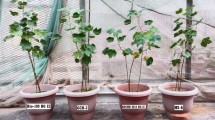Abstract
Several cottonGossypium spp. race stocks have been identified that possess resistance to the boll weevilAnthonomus grandis Boh. because oviposition is decreased. In this work, a number of known cotton constituents that influence stimulation of feeding and attractancy for this insect were found to have little or no influence on oviposition. These include gossypol, β-bis-abolol, caryophyllene, some fatty acids and their methyl esters, some wax esters, flavonoids, condensed tannins, and chrysanthemin. Analysis of cotton bud surfaces showed that the content of volatile terpenoids was generally higher in resistant lines, but bioassays did not show decreased oviposition in the presence of the terpenoids. The sugars (glucose, fructose, and sucrose) found in anthers, uniformly stimulated oviposition in the bioassay, and their content was higher in susceptible lines. These results suggest that a major basis of resistance to boll weevils as related to oviposition may be the decreased content of sugars in resistant lines. The analysis of free sugars in the anthers, and perhaps also the analysis of bud surface terpenoids, may provide a basis for selection or genetic production of cotton lines resistant to the boll weevil.
Similar content being viewed by others

References
Belcher, D.W., Schneider, J.C., Hedin, P.A., andFrench, J.C. 1983. Impact of glands in cotton anthers on feeding behavior ofHeliothis virescens (F.) Larvae.Environ. Entomol. 12:1478–1481.
Bell, A.A., andStipanovic, R.D. 1977. The chemical composition, biological activity, and genetics of pigment glands in cotton,in Proc. Beltwide Cotton Prod. Res. Conf., Atlanta, Georgia, January 10–12, 1977. National Cotton Council, Memphis, Tennessee, pp. 244–258.
Bird, T.G., Hedin, P.A., andBurks, M.L. 1987. Feeding deterrent compounds to the boll weevil in rose-of-Sharon.J. Chem. Ecol. 13:1087–1097.
Chan, B.G., andWilson, F.D. 1987. A new coumarin in cotton, pp. 106–107,in Proc. Beltwide Cotton Prod. Conf., New Orleans, Louisiana, Jan. 3–8, 1988. National Cotton Council, Memphis, Tennessee.
Chan, B.G., Waiss, A.C., Binder, R.G., andElliger, C.A. 1978. Inhibition of lepidopterous larval growth by cotton constituents.Entomol. Exp. Appl. 24:94–100.
Chang, J.F., Benedict, J.H., Payne, T.L., andCamp, B.J. 1988. Volatile monoterpenes collected from the air surrounding flower buds of seven cotton genotypes.Crop Sci. 28:685–688.
Cohen, S.A., Bidlingmeyer, B.A., andTarvin, T.L. 1986. PITC derivatives in amino acid analysis.Nature 320:769–770.
Collum, D.H., Hedin, P.A., White, W.H., Parrott, W.L., Jenkins, J.N., andGrimley, E.B. 1981. Studies on the structural properties of cotton tannin and its toxicity to the tobacco bud-worm. Abstracts of papers, 182nd National Meeting of the American Chemical Society, New York. American Chemical Society, Washington, D.C. Pest Abstract No. 54.
Dean, R.W., andChapman, P.J. 1973. Bionomics of the apple maggot in eastern New York,Search Agric. Entomol. 3:10.
Elzen, G.W., Williams, H.J., Bell, A.A., Stipanovic, R.D., andVinson, S.B. 1985. Quantification of volatile terpenes of glanded and glandlessGossypium hirsutum (L.) cultivars and lines by gas chromatography.J. Agric. Food Chem. 33:1079–1082.
Hanny, B.W. 1980. Gossypol, flavonoid, and condensed tannin content of cream and yellow anthers of five cotton cultivars.J. Agric. Food Chem. 28:504–506.
Hedin, P.A., Minyard, J.P., Thompson, A.C., Struck, R.F., andFrye, J. 1967. Constituents of the cotton bud. Identification of the anthocyanin as chrysanthemin.Phytochemistry 6:1165–1167.
Hedin, P.A., Miles, L.R., Thompson, A.C., andMinyard, J.P. 1968. Constituents of the cotton bud. Formulation of a boll weevil feeding stimulant mixture.J. Agric. Food Chem. 16:505–513.
Hedin, P.A., Jenkins, J.N., andMaxwell, F.G. 1977. Behavioral and developmental factors affecting host plant resistance to insects, pp. 231–275,in P.A. Hedin, (ed.). Host Plant Resistance to Pests. ACS Symposium Series No. 62, American Chemical Society, Washington, D.C.
Hedin, P.A., Jenkins, J.N., Collum, D.H., White, W.H., andParrot, W.L. 1982. Multiple factors in cotton contributing to resistance to the tobacco budworm, pp. 349–365,in P.A. Hedin, (ed.). Plant Resistance to Insects. ACS Symposium Series No. 208, American Chemical Society, Washington, D.C.
Horwitz, W. (ed.). 1975. Methods of Analysis of the Association of Analytical Chemists, 12th ed. Washington, D.C. 1094 pp.
Jenkins, J.N.,Parrott, W.L.,McCarty, J.C., andEarnheart, A. 1978. Evaluation of primitive races ofGossypium hirsutum L. for resistance to boll weevil. Mississippi Agric. For. Exp. Stn. Tech. Bull. 9.
Keller, J.C., Maxwell, F.G., andJenkins, J.N. 1962. Cotton extracts as arrestants and feeding stimulants for the boll weevil.J. Econ. Entomol. 55:800–801.
Lambert, L., Jenkins, J.N., Parrott, W.L., andMcCarty, J.C. 1980. Evaluation of foreign and domestic cotton cultivars and strains for boll weevil resistance.Crop Sci. 20:804–806.
Lusby, W.R., Oliver, J.E., Mckibben, G.H., andThompson, M.J. 1987. Free and esterified sterols of cotton buds and anthers.Lipids 22:80–83.
McCarty, J.C., Jr., andParrott, W.L. 1987. Genetic resistance to boll weevil oviposition in primitive cotton.Crop Sci. 27:263–264.
McKibben, G.H., Thompson, M.J., Parrott, W.L., Thompson, A.C., andLusby, W.R. 1985. Identification of feeding stimulants for boll weevil from cotton buds and anthers.J. Chem. Ecol. 11:1229–1238.
Minyard, J.P., Hardee, D.D., Gueldner, R.C., Thompson, A.C., Wiygul, G., andHedin, P.A. 1969. Constituents of the cotton bud. Compounds attractive to the boll weevil.J. Agric. Food Chem. 17:1093–1097.
Stipanovic, R.D., Altman, D.W., Begin, D.L., Greenblatt, G.A., andBenedict, J.H. 1988. Terpenoid aldehydes in upland cottons: Analysis by aniline and HPLC methods.J. Agric. Food Chem. 36:509–515.
Struck, R.F., Frye, J., Shealy, Y.F., Hedin, P.A., Thompson, A.C., andMinyard, J.P. 1968a. Constituents of the cotton bud. IX. Further studies on a polar boll weevil feeding stimulant complex.J. Econ. Entomol. 61:270–274.
Struck, R.F., Fryee, J., Shealy, Y.F., Hedin, P.A., Thompson, A.C., andMinyard, J.P. 1968b. Constituents of the cotton bud. XI Studies of a feeding stimulant complex from flower petals for the boll weevil.J. Econ. Entomol. 66:664–667.
Waiss, A.C., Chan, B.G., Elliger, C.A., andBinder, R.G. 1981. Biologically active cotton constituents and their significance in HPR. pp. 61–63,in Proc. Beltwide Cotton Prod. Res. Conf., New Orleans, Louisiana, January 4–8, 1981, National Cotton Council, Memphis, Tennessee.
Wakelyn, P.J., Stipanovic, R.D., andBell, A.A. 1984. Identification of scopoletin in dried bract of the cotton plant.J. Agric. Food Chem. 22:567–568.
Author information
Authors and Affiliations
Rights and permissions
About this article
Cite this article
Hedin, P.A., Mccarty, J.C. Possible roles of cotton bud sugars and terpenoids in oviposition by the boll weevil. J Chem Ecol 16, 757–772 (1990). https://doi.org/10.1007/BF01016487
Received:
Accepted:
Issue Date:
DOI: https://doi.org/10.1007/BF01016487



